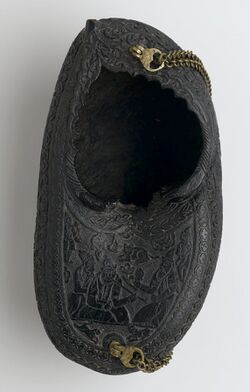Engineering:Kashkul
Kashkul (Persian: کشکول, Kashkūl, pronounced: kashkool) also referred to as the beggar's bowl, is a container carried by wandering Dervishes (belonging to the Sūfī sect of Islam) and used to collect money and other goods (sweets, gifts, etc.) usually after a street session of poetry recitation, religious eulogies, advice or entertainment.[1][2][3][4] The container, usually a bowl shaped like a ship, is made out of material such as coco-de-mer shell, clay, metals (usually brass), wood or ceramics and is hung over the shoulder using a metal chain.[5]
Etymology
Kashkūl is a compound word composed of the words konash (کنش) meaning 'to make' and kol (کل) meaning 'complete, full'. The vowel on the first letter of the first word is changed to a instead of o and the sound n (ن) is removed. In the second word, the vowel o is changed to ū. Together it indicates that all of the Dervish's worldly assets are in the container and therefore asking people to fill it through donations and gifts.[6]
History
The exact dates of the usage of the kashkul containers are not known. However, there are metal kashkul containers dated to around the 16th century at the time of the Iranian Safavid dynasty. There are also references to the crescent-shaped kashkuls used to serve wine dated to around the 13th century.[7][8]
See also
References
- ↑ Hayyīm, Sulaimān (1934), Complete and Modern, Designed to Give the English Meanings of Over 50,000 Words, Terms, Idioms, and Proverbs in the Persian Language, as Well as the Transliteration of the Words in English Characters. Together with a Sufficient Treatment of All the Grammatical Features..., Librarie-imprimerie Béroukhim. Digitised 17 April 2008, University of Michigan, https://books.google.com/books?id=lxBgAAAAMAAJ&q=Kashkool
- ↑ Haim, S (1998), Farhang Moaser: English Persian, Persian English Dictionary (in one volume), Farhang Muaser Publishers p.352 (Persian to English)
- ↑ Vambery, A (1889), The Newbery House Magazine, Volume 1, The Dervishes. (Personal Recollection), Griffith Farran Okeden & Welsh, https://books.google.com/books?id=EA8RAAAAIAAJ&q=kashkul+dervish&pg=RA5-PA342, pp.341-342
- ↑ Koelz, Walter (1889), Anthropological Papers, University of Michigan. Museum of Anthropology Issues 71-72 of Persian Diary, 1939-1941, Walter Koelz, Museum of Anthropology, University of Michigan. Digitized October 14, 2011, the University of California, ISBN 9780932206930, https://books.google.com/books?id=9VFSAQAAIAAJ&q=Kashkul+anthropology, p.134
- ↑ The Met 150, Beggar's Bowl (Kashkul) late 19th–early 20th century, The Met (accessed=March 20, 2020), https://www.metmuseum.org/art/collection/search/786860
- ↑ لغت نامه دهخدا: کشکول, Online Abadis Dictionary (accessed=March 20, 2020), https://dictionary.abadis.ir/fatofa/%DA%A9%D8%B4%DA%A9%D9%88%D9%84/
- ↑ The Aga Khan Museum, KASHKUL (BEGGING BOWL), Aga Khan Museum (accessed=March 20, 2020), https://www.agakhanmuseum.org/collection/artifact/beggars-bowl-kashkul-akm612
- ↑ Welch, Anthony (1973), Shah ʹAbbas & the arts of Isfahan An Asia House Gallery publication, The Asia Society; distributed by New York Graphic Society. Digitized November 19, 2009, the University of Michigan, ISBN 9780878480418, https://books.google.com/books?id=BhzqAAAAMAAJ&q=Kashkul+safavi, p.134
 |


